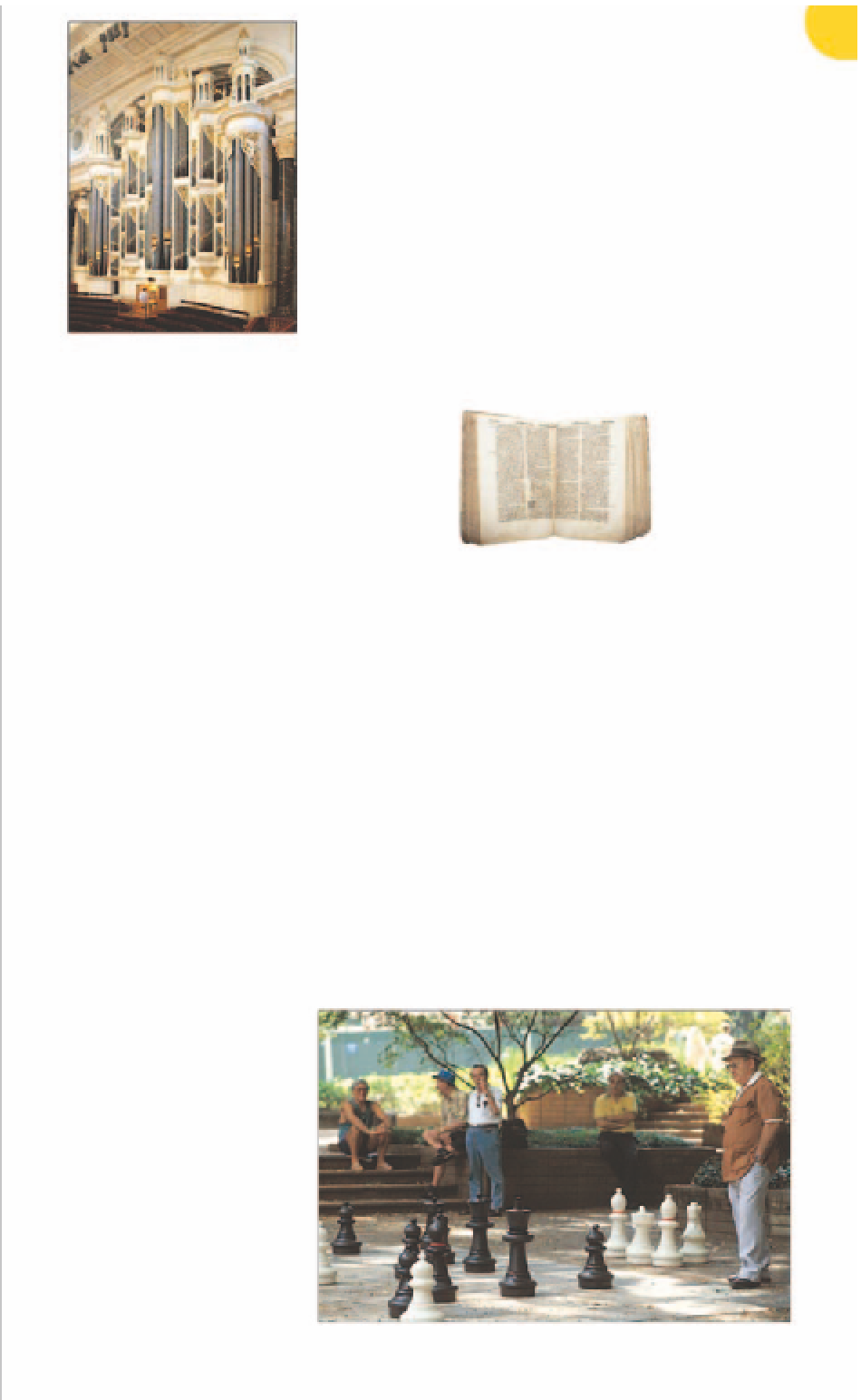Travel Reference
In-Depth Information
St Andrew's
Cathedral
e
Sydney Square, Cnr George &
Bathurst Sts.
Map
4 E3.
Tel
9265
1661.
died during its construction, as
did several of the architects
who followed. The vestibule -
an elegant salon with intricate
plasterwork, lavish stained
glass and a crystal chandelier -
is the work of Albert Bond.
The Bradbridge brothers
completed the clock tower in
1884. From 1888-9, other
architects were used for the
Centennial Hall, with its
coffered zinc ceiling and the
imposing 19th-century Grand
Organ with over 8,500 pipes.
On the façade, you will see
numerous carved lion heads.
Just to the north of the main
entrance, facing George Street,
a lion has been
carved with one
eye shut. This
oddity appeared
because of the
head stonema-
son's habit of
checking the line
of the stonework
by closing one eye.
The sly joke was not
found until work was finished.
Some people have conclud-
ed that Sydney Town Hall
became the city's most elabo-
rate building by accident, as
each architect strove to outdo
similar buildings in Manchester
and Liverpool. Today, it makes
a magnificent event venue.
Contact the cathedral for opening
hours and tour times.
@
George St routes.
#
www
.cathedral.sydney.anglican.
asn.au
6
7
8
While the foundation stone or
the country's oldest cathedral
was laid in 1819, almost 50
years elapsed before the
building was consecrated in
1868. The Gothic Revival
design is by Edmund Blacket,
whose ashes are
interred here.
Inspired by York
Minster in
England, the
twin towers
were completed
in 1874. In 1949,
the main entrance
was moved to the
eastern end near
George Street. Inside are
memorials to Sydney pioneers,
including Thomas Mort
(see
p72)
, as well as a collection of
religious memorabilia.
The southern wall incorpor-
ates stones from London's St
Paul's Cathedral, Westminster
Abbey and the House of Lords.
The Grand Organ in Sydney Town
Hall's Centennial Hall
Sydney Town
Hall
w
483 George St.
Map
4 E2.
Tel
9265 9333.
@
George St
routes.
#
8:30am-6pm Mon-Fri.
¢
www
.
cityofsydneyvenues.com.au
public hols.
7
8
The Great Bible,
St Andrew's Cathedral
The steps of this sandstone
building, central to George
Street's Victorian architecture,
have been a favourite Sydney
meeting place since it opened
in 1869. Walled burial grounds
had originally covered the site.
It is a fine example of high
Victorian architecture. The
original architect, JH Wilson,
Obelisk
This monument was dubbed
“Thornton's Scent Bottle” after
the mayor of Sydney who had
it erected in 1857. The mock-
Egyptian edifice is in fact a
ventilator for a sewer.
ran through the park, and after
the rail system was opened in
1926 the entire area had to be
remodelled and replanted.
John Busby, a civil engineer,
conceived and supervised the
construction of the 4.4-km (2¾-
mile) tunnel. It carried water
from bores on Lachlan Swamp,
now within Centennial Park
(see p127),
to horse-drawn
water carriers on the corner
of Elizabeth and Park Streets.
Busby's Bore Fountain
This is a reminder of Busby's
Bore, the city's first piped
water supply opened in 1837.
Emden
Gun
Standing at the corner of
College and Liverpool Streets,
this monument commemorates
a World War I naval action.
HMAS
Sydney
destroyed the
German raider
Emden
off the
Cocos Islands on 9 November
1914, and 180 crew members
were taken prisoner.
City Circle Railway
The park we see today bears
very little resemblance to the
Hyde Park of old. In fact, the
dictates of city railway tunnels
have largely created its present
landscape. Tunnels were exca-
vated through an open cut that
Game in progress on the giant chessboard, near Busby's Bore Fountain








































